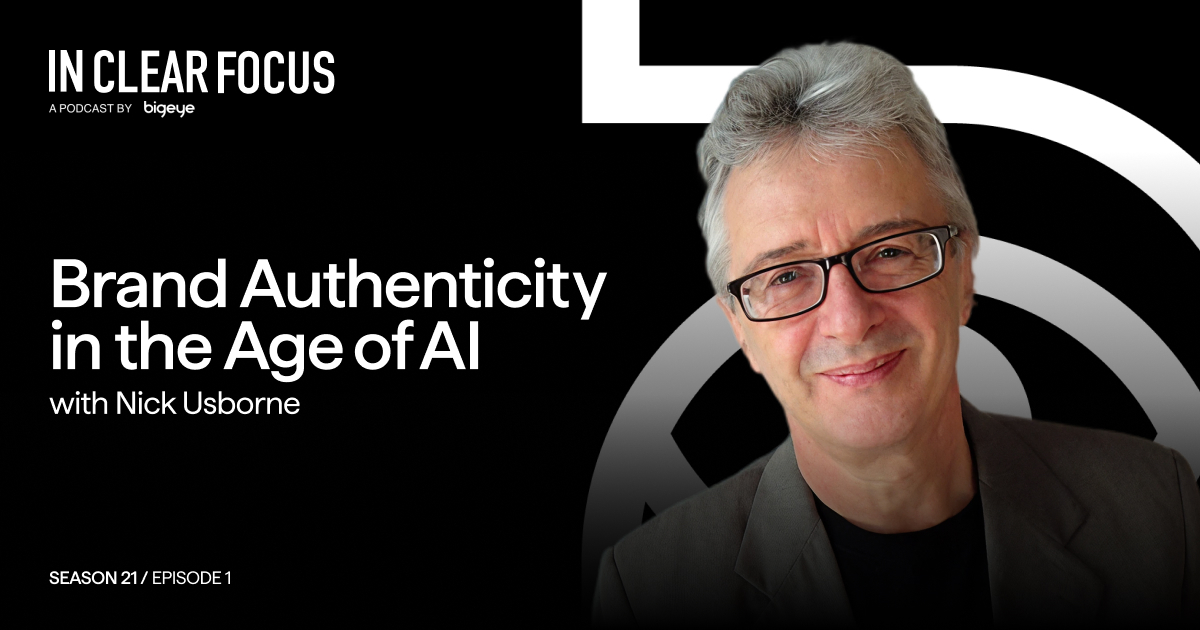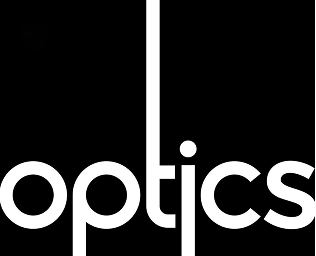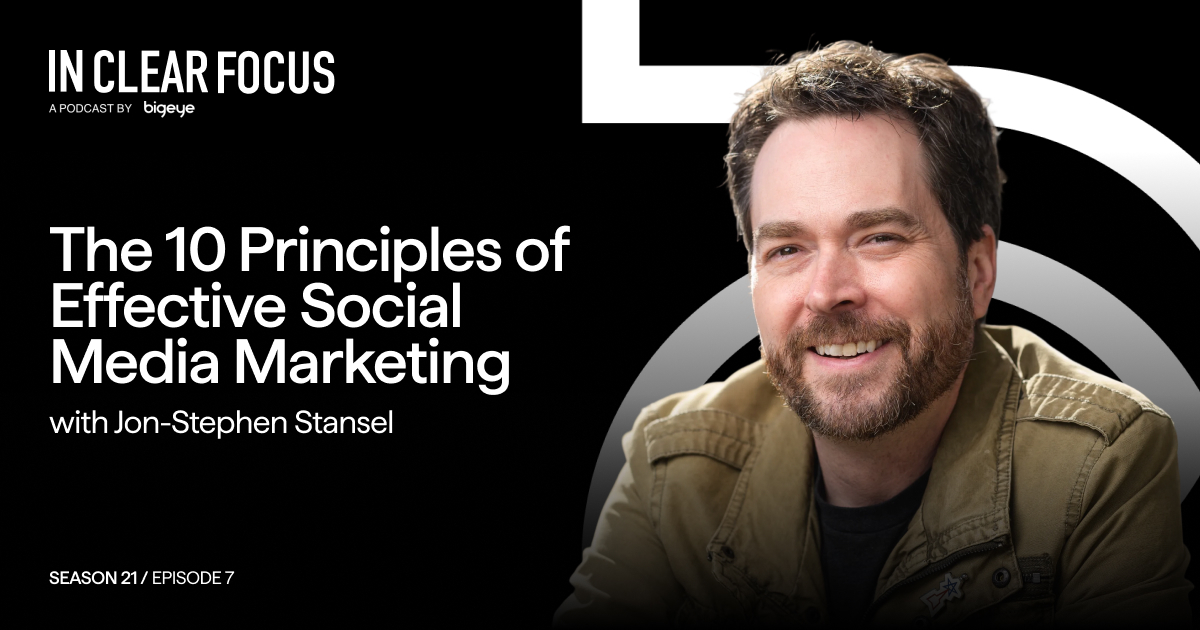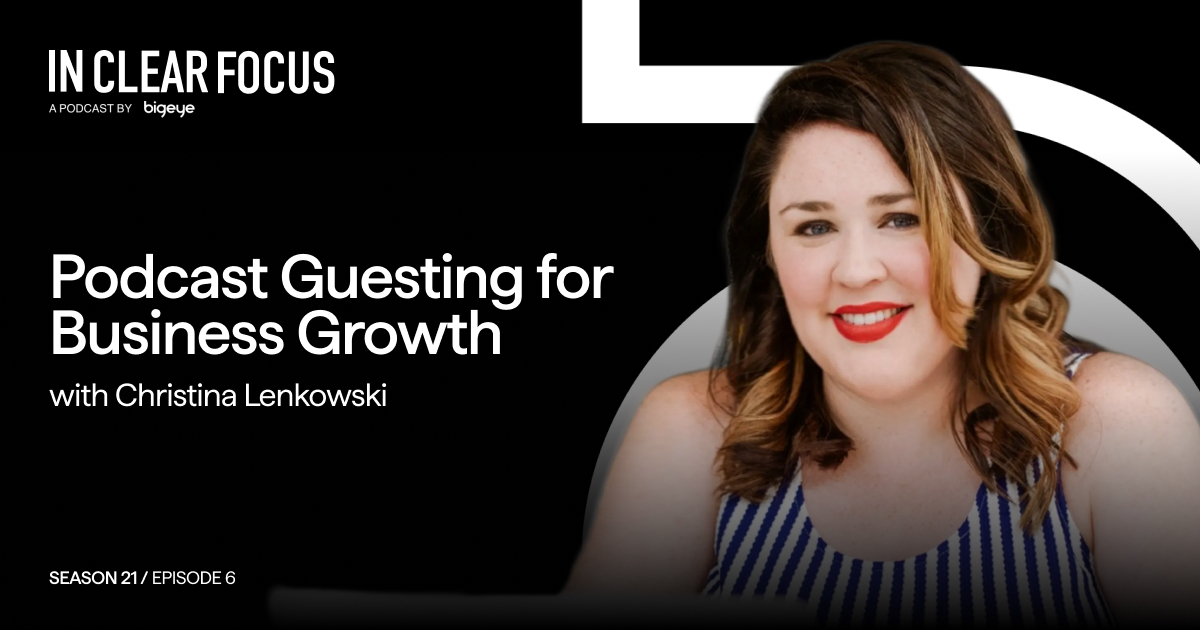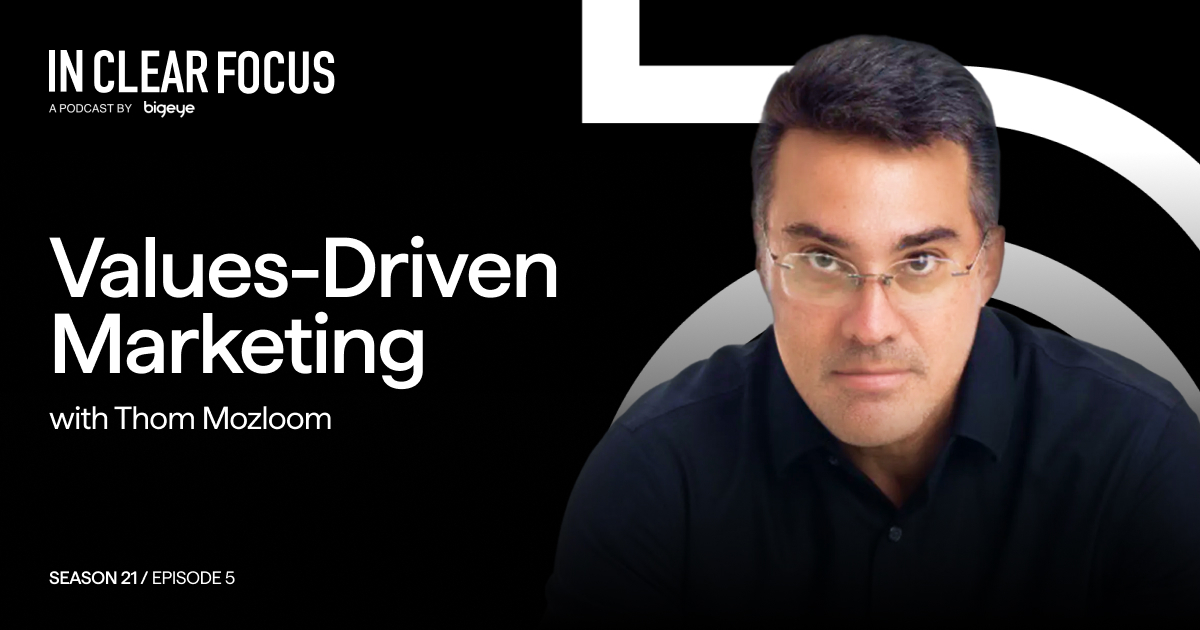IN CLEAR FOCUS: Veteran copywriter Nick Usborne explains how to combat “brand drift” with a story-first, AI-powered content strategy. Nick introduces his Story Aligned framework, arguing that a brand’s unique story is its only defensible moat against the “sameness trap.” He reveals why marketers must lead with story when prompting AI. Learn how to use structured prompts to scale content while preserving the human touch and authentic brand communication that builds lasting trust.
Episode Transcript
Adrian Tennant: Coming up in this episode of IN CLEAR FOCUS
Nick Usborne: You’ve got to build your foundation on story, because in a world of AI, that is the only thing you can protect. And you should leverage it so that you have that solid base of a unique story that will always differentiate you from the competition, however much you create content at scale.
Adrian Tennant: You’re listening to IN CLEAR FOCUS, fresh perspectives on marketing and advertising produced weekly by Bigeye, a strategy-led full-service creative agency growing brands for clients globally. Hello, I’m your host, Adrian Tennant, Bigeye’s Chief Strategy Officer. Thank you for joining us. As artificial intelligence transforms how brands and agencies create content, many are discovering that AI can produce generic messaging that’s indistinguishable from competitors. Our guest today has developed a new framework to help marketers navigate this challenge. Nick Usborne is a highly awarded copywriter, author, and coach with over 40 years of professional experience. Beginning his career in the late 1970s at a London advertising agency during what many consider to have been the golden age of creative advertising, Nick has worked with clients including Apple, Microsoft, Citibank, The New York Times, and Disney. In 1997, he pioneered the transition from traditional direct mail to online copywriting, authoring “Net Words: Creating High Impact Online Copy,” which was one of the first books dedicated to web copywriting. Today, Nick is the founder of Story Aligned, a new training program that helps senior marketers scale AI-generated content while preserving their unique brand identity and voice. To discuss the challenges of what he’s dubbed brand drift, the power of story-first frameworks, and why authentic brand communication will become critical as AI adoption increases, I’m delighted that Nick is joining us today from Montreal, Quebec. Nick, welcome to IN CLEAR FOCUS.
Nick Usborne: Adrian, thank you very much for inviting me. I’m honoured and I’m excited. I’m excited for our conversation. Me too.
Adrian Tennant: Well Nick, let’s start with your journey. You began your career in London advertising in 1979. Can you describe what the world was like and how it influenced your approach to brand communication?
Nick Usborne: It was at the end days of the creatives ruling the agency world. So, copywriters, art directors had their name in the name of the ad agency, like Ogilvy Mather or Albert Mead Vickers. So, yeah, in principle, the copywriters ruled the roost. And I started off as a trainee copywriter, and I just loved the creative focus and the creative urgency of the work. And I found I was reasonably good at it. And I loved it. I loved the craft of it. I loved the challenge of doing good work. I loved the creativity of the people around me. London was a wonderful advertising creative scene in a way I don’t think you can replicate today. Advertising was almost kind of part of the vibe of the city. People would say, not people in the industry, but just regular people would say, “Oh hey, did you see the latest Benson & Hedges ad?” Or “Did you see the latest Volvo ad?” Because they were fun, they were interesting, they were provocative. And yeah, creativity ruled. And as time passes, if we go slow motion from then to now, the creative has fallen back in focus in some way. And now it’s much more data-driven. It’s all about the data. So, I kind of miss the creativity and the craft and the pride in craft of those early days. I get the reasons for the shift, I understand it, I see what’s going on, I’ve participated in it. That was my roots, as copywriting as a craft, as an art, as a commentary on life.
Adrian Tennant: Yeah, as part of the culture.
Nick Usborne: Yeah, very much.
Adrian Tennant: Well, in 1997, you made the transition from traditional direct mail to online copywriting. Nick, what drove that decision, and what did you learn about adapting brand messaging for digital channels?
Nick Usborne: I did it because I’m just intensely curious about new stuff. And I, in fact, created my first website in 1995. This was a personal one. I lived at a hobby farm and I created a website for the farm, which was crazy back in 1995. But I thoroughly enjoyed it, and I saw the potential. And then I went full-time commercially in 1997. And in terms of brand, I think the most important thing that I noticed and I spoke about and I taught was all of a sudden we were in a space, a medium where the audience could talk back. So, you know, I used to write direct mail for Diners Club back when Diners Club was big. And, you know, you’d have these classic openings to letters saying, “You have been specially selected …” And you could get away with it because you weren’t going to walk down the street and knock on the door of your neighbor and say, “Hey, were you specially selected too?” And suddenly discover everyone in the street was specially selected. You didn’t do that. But with the web, the customer, the consumer was also a participant and a creator. Even in the early days, even before blogs and Facebook and stuff, people were finding ways through discussion lists and forums to participate. And for a brand, lots of brands were kind of caught on their back foot. Because they say something outrageous, and for the first time ever, part of their audience would step up and say, “I don’t think so.” The company and the brand manager would be like, “Whoa, hang on a minute, the audience is meant to be quiet, shush, don’t talk back.” But with the internet, and especially then with the rise of blogging and social media, the audience can talk back. And there’s classic stories where brands have made mistakes and people crucify them for it. So that was probably the first thing I noticed is, “Whoa, the audience gets to talk back!”
Adrian Tennant: Well, fast forward almost three decades to today, you’ve launched Story Aligned to address what you call brand drift. Nick, can you explain what brand drift is and why it’s becoming such a critical issue for businesses?
Nick Usborne: Okay, so to be clear and transparent, I don’t think I invented the term “brand drift,” but it’s something I talk about a lot. So again, I’m just going to go back a ways. Quite a while back, I did some work for Apple. And we were the agency of record for a particular portion of their business. And a few weeks after we got the account, this huge binder is thrown onto my desk. The brand guide, it’s like what you can and can’t do with the brand. So very, very tight control with how the logo is used, what you say, how much white space there is, et cetera, et cetera. I mean, it was a thick, thick volume. So that’s that. So the companies understood very much, and particularly companies like Apple, the importance of brand and protecting and building that brand and building an audience. and engagement around the brand. So now we jump forward to a world of AI, where in any given company, there will be some people using AI, some people not. Some companies will be training people in the use of AI, many still not. So people are using AI for communications, for copy, for content, for customer service, things like that. But when people use AI, they might use it in different ways, and it comes out with this different language. So companies are drawn to the idea that they can create content at scale, or they can fire half of their customer service people and use AI instead. They’re beginning to lose control of the language that is being used because nobody’s looking at that big, thick binder anymore. And that’s what I mean by brand drift is suddenly like a brand manager or a senior marketing person is going to look at communications that have gone out and said, “Oh, hang on. That doesn’t sound quite right.” And it’s that moment where you say, “Hang on, that doesn’t sound quite how we should be sounding.” That is where you identify brand drift and think, “Whoops!” And now you step back. So the whole idea of Story Aligned is to help people within marketing groups actually avoid that moment altogether. So they never have that ‘whoops’ moment of “This doesn’t sound like us.”
Adrian Tennant: That makes sense. Well, relatedly, you believe that many brands also fall into what you call the sameness trap when using AI. What does this look and sound like in practice?
Nick Usborne: It’s never been this easy, never before been this easy for me to sound like you, for instance. I could scrape all your previous podcasts. I could analyze how you talk and the language you use and the way in which you speak, and I can copy you. I can do that with AI. I could have always done it, but it would be ridiculously hard for me to have done it before, but I can do it now in a matter of minutes, which means that you no longer have a guardrail around what you say, how you say it. Meanwhile, everyone is using these AI tools, and many of them are using the same models, like ChatGPT, because the majority of people in companies, that is the base model that they use. They use ChatGPT. They are probably finding the same group of prompt guides, “Top 20 Prompts for Marketers Today. You’ll be blown away by number 19.” You know, that kind of stuff.
Adrian Tennant: Love a good listicle!
Nick Usborne: So you’ve got people using the same models, the same tools, working from the same prompts. So if they’re working in the same company, fine. But if they’re working in different organizations, you could have three companies that are in the same industry. And they all have people using the same models and the same prompt guides. And guess what? You start sounding the same as everyone else. And that then is the sameness trap that you fall into. And it’s not necessary. You can use AI without falling into that trap. But if you kind of fall for the idea of, “Oh, hey, we can just automate this. Hey, we can take this out of the human domain.” It’s a bit like looking at a conveyor belt in a physical factory where everything flies off the end of the conveyor belt without any quality control. Nobody’s looking to see that the product’s even in the box before it hits the shipping container. So that’s part of it, is that oversight and that protection of what makes you as a brand unique. What you say, how you say it. And also the story of your company.
Adrian Tennant: Which seems a perfect moment to introduce your Story Aligned framework. Let’s get into it. You organize brand elements into three categories: story, narrative, and voice. Nick, can you walk us through what story means in this context?
Nick Usborne: Story, to me, is the most important element because, as I said before, your voice, I can steal it. I can steal anyone’s voice. What you say, the phrases you use, the kind of language you use, I can steal that. I can scrape it, use it, steal it, whatever. Your story, I can’t take that. That’s yours. That’s your life lived. You can’t take me. You can’t take my story as a human being. It’s the same with companies. Companies all have unique origin stories. They have unique founder stories. They have unique moments in their existence where it looked like everything was going to end in disaster, and they recovered. It was conflict resolution or something like that. Every company has its storie,s and this is your moat. This is your moat. But I don’t see brands working that. I see brands focusing primarily on narrative and voice, what you say and how you say it. And there is no moat there, because I can copy it, I can copy it. And that’s, again, you’re sounding the same. So the purpose of my training and the purpose of what I write about and talk about is that you’ve got to build your foundation on story. Because in a world of AI, that is the only thing you can protect. And you should leverage it, so that even if you want to build out content at scale, or customer service, or whatever it is at scale, you have that solid base of unique story that will always differentiate you from the competition, however much you create content at scale.
Adrian Tennant: How does narrative differ from story in your framework? And why is this distinction important for brands?
Nick Usborne: Well, story is literally the story where I sit around with a cup of coffee and tell you about how I founded my company or whatever it is. Narrative is the language that we use to describe ourselves or position ourselves. So, hey, with Nike, “Just do it.” “Just do it” is part of the narrative core of that company. There are phrases, there are terms that it could be a tagline. “Think different.” “Where’s the beef?” “Got milk?” Like all these taglines, that’s narrative. These are the words that we use. And in fact, there is a certain amount of moat protection there. Because if I launch something else and have the tagline, “Think different,” people are going to say, “Nah, nothing.” I can’t say that, someone’s already got that line. So there’s a certain amount of protection. But for most of us, without incredibly important brands like Apple or Nike or something, it is just the language we use every day. It’s the kind of thing that we repeat every day. It’s what we say to our customers at the checkout. It’s the language that all the new employees, interns: “Here’s what we say, here’s what we don’t say. We never promise that you’ll be healed, but we do promise this. We don’t say this, but we do say this.” So these are the narrative elements in our communications. And then the voice is simply how we say it. And you come across narrative and voice are part of every prompt library. “You know, “Don’t say this, do say this, use this phrase, don’t use this phrase.” In terms of voice, everyone’s describing voice in similar ways. And so yeah, you do – you end up sounding like everyone else, unless you build everything on story, and you let story direct the way. Because there, now you can differentiate yourself. So while everyone else is beginning to sound the same, you can maintain your brand integrity.
Adrian Tennant: Let’s take a short break. We’ll be right back after this message.
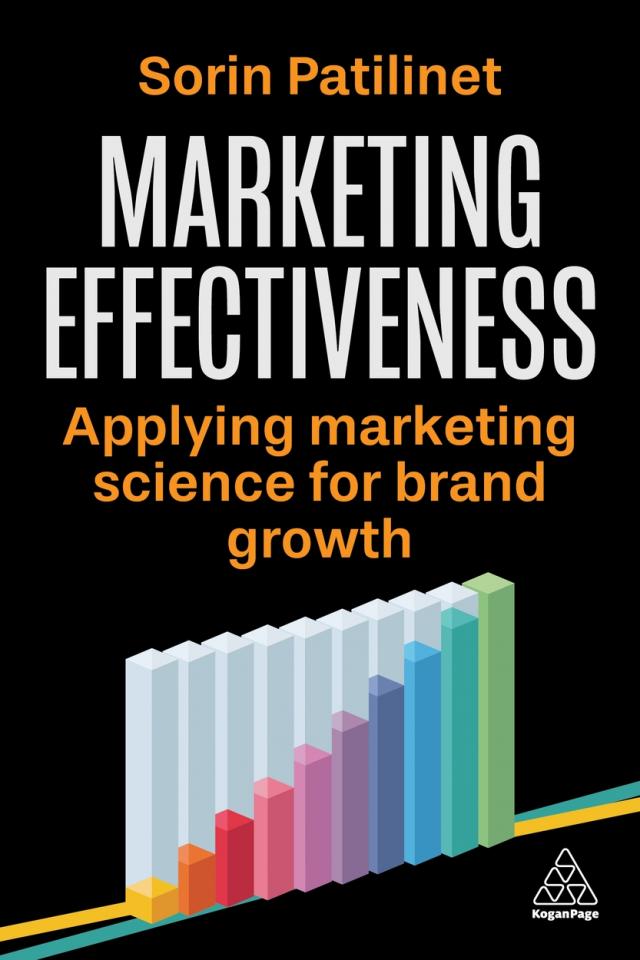 |
Sorin Patilinet: Hello, I’m Sorin Patilinet, the author of Marketing Effectiveness: Applying Marketing Science for Brand Growth published by Kogan Page.
Drawing on my over 20 years of experience, I reveal how marketers can bridge the gap between creativity and analytics to drive sustainable growth. Whether you’re a mid- to senior-level marketeer facing pressure to deliver quantifiable results, or someone looking to integrate advanced measurement into your marketing strategies, my book provides practical frameworks and real-world examples from brands like Snickers, Unilever’s Dove, and M&M’s. You’ll discover how to leverage neuroscience or machine learning to deepen customer understanding, navigate AI’s evolving role in marketing, and lastly, develop the skills needed to thrive as a modern marketeer. As an IN CLEAR FOCUS listener, you can save 25% on Marketing Effectiveness when you order directly from KoganPage.com. Just enter the exclusive promo code BIGEYE25 at checkout. Shipping is always complimentary for customers in the US and the UK. I hope my book helps you apply marketing science to create measurable success and elevate your marketing career. Thank you! |
Adrian Tennant: Welcome back. I’m talking with Nick Usborne, an expert in AI-powered brand storytelling and the founder of Story Aligned. Nick, when we were preparing for this podcast, you mentioned to me that most companies lead with voice and narrative when prompting AI, but you recommend leading with story. Why is this approach more effective?
Nick Usborne: It allows you to use AI at scale without losing that kind of protective moat around your brand. Because yes, you want the narrative. Yes, you want the voice. Yes, you want to create content at scale. But you don’t want to sound like a competition. And you don’t want to lose that kind of hard-won brand narrative that has built trust, sometimes over decades. There are legacy companies out there that have been building trust in their brand for decades, and it’s easy to lose. So we talked very early on in this conversation about how I said back in 1997, one of the things I’ve noticed is that the consumer, the customer can talk back. And there was a threat to the brand there. You had to be more careful about what you said because people can talk back. So there’s a little bit of a parallel now with the rise of AI is the tool is so attractive, so compelling from a cost point-of-view. that it is almost irresistible. But again, you’ve always got to be mindful of that threat to your brand, just like back in 1997. But yeah, the whole point of a story is that it will always be unique to you. So, so long as you don’t dilute it, so long as you don’t forget it, so long as you don’t mess with it, story will be your best friend, so that you will always be different because you’re kind of leaning into story, into what makes you unique. It’s the lived experience of the company, which no other company has.
Adrian Tennant: Got it. When you’re conducting training for the Story Aligned framework, you recommend moving away from conversational AI prompting toward more structured approaches. Can you give us an overview of this methodology?
Nick Usborne: Yeah, and in the training, we talk about story, narrative, voice, and more after that. And in each element, I talk about how to structure the prompts. And in fact, we get very formal. There’s frameworks and rubrics we use to formalize that. And that is so that everyone in the organization is working from the same prompt. Because these large language models, they’re not like software. If I’m using Excel in one department and you’re using Excel in a different division of the company, and we put in the same input, we’ll get exactly the same output because it’s a program. It’s Excel. I don’t have to worry about you seeing some slightly different figures than the ones I’m looking at. If the input is the same, the output will be the same. It’s not true with the large language models. I can put in, in fact, exactly the same phrase as you, almost, and they won’t be identical outputs. But the difficulty is if what we input is actually significantly different at the beginning, and now the output is going to be very different. And again, so this is about protecting brand. If we have slightly different prompts, or maybe even using different models across an organization with slightly different prompts from different prompt libraries, the brand voice is going to come out different. So I try to formalize that. In a sense, it’s kind of almost unlike me, because like I said earlier, I come very much from the creative department and creative mindset. But here, I can see an urgent need to have a very, very formal structure. So, in fact, what I do is I show people, one, how to arrive at the prompts, but then also how to express them. In each case, with each session, we kind of express the prompt library, as it were, as a JSON file. JSON file is not a programming language, but it is a formal way to organize data. And the nice thing about a JSON file is that it is equally easy for a human and a machine to read it. We both understand it, humans and machines. And what it does is it removes almost all the uncertainty, all the ambiguity that can happen between different people putting in different inputs. So it’s kind of weird. In one sense, I’m looking at this whole process through the eye of a creative agency person. On the other hand, I’m getting really deep down into formalizing this so that everyone across the organization can work from the same JSON files. with an output that is consistent in the way it supports the brand. And not just the brand, but also, hey, maybe it’s a campaign, maybe it’s a promotion, maybe it’s internal communications, whatever it is. This is how you can create at scale, but still hang on to narrative consistency and kind of avoid brand drift.
Adrian Tennant: Who is your ideal customer?
Nick Usborne: Everyone who’s going to be using these models within companies, ultimately the customer, I’d like them to have access to it. My ideal audience as a business owner is chief marketing officers, but my ideal audience for users are the people in the brands who are actually using these large language models to create copy and content and other information within organizations.
Adrian Tennant: You mentioned the role that humans still play in this process, at least for now. What role does emotional intelligence play in your approach to AI-powered content creation?
Nick Usborne: It’s part of the filter. Now, two years ago, I would have said these large language models like ChatGPT don’t understand emotional intelligence. They actually do, in a second-hand kind of way. They’ve read the script to Love Story and Romeo and Juliet. They know what love is, but they’ve never experienced it. They’ve never been in love or had their hearts broken. So, it’s kind of a second-hand experience, when we have lived experiences like eating ice cream. This last weekend we went away and we had just way too much ice cream and it made us feel sick, but it was just gorgeous to eat it. A large language model can’t eat ice cream, and it would never make the foolish decision to eat too much in the knowledge… That’s what humans do. And that’s part of our emotional intelligence, our awareness of our emotional selves, our awareness and empathy for other people, is part of emotional intelligence. Our ability to interact sometimes in difficult circumstances, in a tough meeting at work, is a sign of high emotional intelligence when you navigate that successfully. So again, I want to bring this to the table because there’s a temptation to avoid it, that whole human side. There’s a temptation to over-automate. Now, I’m a huge fan of automating. I use artificial intelligence to a huge degree myself. I use it every day. I probably get two or three days’ work done every day now because I’m using artificial intelligence. But I’m also very, very mindful that just for myself, as simple me, as a very kind of small business owner, that if I cease to be me, most of my brand disappears. You know, there’s that line I have to tread myself: how do I maximize the use of the tools without losing that relationship and that kind of humanity? And like you say, the human intelligence that I can bring to the table on a good day, human intelligence is great. I’ve stood on stages and said, “Hands up, everyone who thinks they have higher than average emotional intelligence.” And everyone’s saying, yes. There’s a lot of things we think we’re all good at, but most of us, if you think really carefully about it, are probably not that good. But again, that’s what makes us human, the messiness of it all. So I want to bring in the formal structure of teaching people how to use these tools, of maintaining that kind of brand integrity. But also, I don’t forget the messiness, which is central to us being human and is incredibly attractive. People are not attracted to AI-generated content. As soon as somebody, a consumer, a reader, reads something or sees something and there’s something there that makes them think, “Oh man, this is AI” there is a huge sense of disappointment, a sense of loss, a sense of mistrust and fall off in revenue. People put their wallet back in their pocket because they don’t want that. So there is a line, there’s a narrow line to walk here of automating but also making sure you’re aligned with your story, with your humanity.
Adrian Tennant: You’ve been writing professionally for over four decades. What fundamental principles of good copywriting remain constant regardless of the tools being used?
Nick Usborne: Oh goodness, so many things. One, as I try to write with a mindset that I like the reader, I respect the reader. It’s not just me throwing words at them. So that again is part of emotional intelligence. For me to understand, to listen first before I write. To understand my audience before I write to them, rather than being the guy who walks into a party and starts talking without listening to a word. So part of my secret sauce as a writer for these years is to spend more time listening and less time writing. I’ve always tried to be conversational in the way that I write. And in fact, this goes back to the early days of my career in London, where if you read a lot of the print advertising of the day, it was conversational, and it was beautifully crafted and carefully written. So again, I try to bring those same elements of craft into my writing now, even when I’m using AI to help me along the way.
Adrian Tennant: Well, looking ahead, how do you see this relationship between AI and brand authenticity evolving? What should marketers be preparing for?
Nick Usborne: But I think it’s going to get very messy for a while. And then we’ll have to find our way out on the other side. My wife showed me an influencer – I think it was on TikTok. And it was this attractive young woman showing off cosmetics and saying, “Buy these cosmetics.” And [my wife] said, “What do you think?” I said, “Well, standard.” And she said, “No, it’s not. It’s AI.” So she showed me the full article. And it’s a company that had created 20 different video avatars of young women, all of them selling the same line of cosmetics. They were generating millions of dollars. And it’s not just that they weren’t people, but that you wouldn’t know they weren’t people. They seemed like energetic young people excited about this product. That’s a very strange place to find ourselves in. And I think everyone, every kind of marketing manager, brand manager should be thinking about this. It’s the kind of thing, whereas if that were actually a significant brand of cosmetics, which it wasn’t, it was just like kind of, I’d never heard of it before. But if it was a famous brand, and they did that, and people called them out on, “Hey, these aren’t real people,” the damage to that brand, which may have been building its credibility for decades, could be huge. So the technology, I think, is going to tempt us into spaces where we shouldn’t actually go. I think every company needs to figure out, “Hey, here’s the tool. Here are the benefits. Here are the dangers. Where is the line? And how do we formalize that? How do we find that for our business? How do we find that best balance of making the most of the technology, but still protecting ourselves long term?”
Adrian Tennant: The largest and probably best-known AI company in the world right now, OpenAI, has recently started advertising. Has it used AI-generated videos for its commercials? No, it hasn’t. Is there a lesson here?
Nick Usborne: I think there’s a lesson there, and it speaks to what we’ve been talking about, is that just because the technology allows it doesn’t mean to say we should always lean into it. There will be times when that isn’t the case. I was watching a video of David Gilmour, formerly of Pink Floyd, and his latest album, and he was recording a song, and it was, I think it was like in an old cathedral or church. And I was just blown away by the number of people involved in recording a single song. There must have been 20 or 30 people, the sound people, the lighting people, just, and that’s this huge, wonderful collection of very talented humans working together to create something. Can you create music with AI? Yes. Can you create music that you enjoy on a long drive out into the country? Probably. Can you create something that is going to last for generations, and people are going to enjoy for generations that way? In a sense, I hope not. I hope it will always take this kind of messy meeting of 20 people working together to create something truly remarkable. That’s my fear, is that some companies are thinking that way. We’ll do everything with AI. “We’ll be AI first. We’ll get rid of the people.” And I get the financial imperative there. You save lots of money, but you lose a lot along the way.
Adrian Tennant: Great conversation. If listeners would like to learn more about Story Aligned or connect with you directly, what’s the best way to do so?
Nick Usborne: Well, just go to storyaligned.com and you can download a white paper there, read my blog posts, learn about the training. Everything we’ve been talking about, I go into in more depth on the website. So enjoy it whichever way you want, storyaligned.com.
Adrian Tennant: Perfect. Nick, thank you very much for being our guest this week on IN CLEAR FOCUS.
Nick Usborne: Thank you for inviting me. It’s been a fun conversation.
Adrian Tennant: Thanks again to my guest this week, Nick Usborne, founder of Story Aligned. As always, you’ll find a complete transcript of our conversation with timestamps and links to the resources we discussed on the IN CLEAR FOCUS page at Bigeyeagency.com, just select ‘Insights’ from the menu. Thank you for listening to IN CLEAR FOCUS, produced by Bigeye. I’ve been your host, Adrian Tennant. Until next week, goodbye.
TIMESTAMPS
0:00: Introduction to IN CLEAR FOCUS
0:22: Meet Nick Usborne
2:23: Nick’s Advertising Journey
4:12: Transition to Online Copywriting
6:16: Understanding Brand Drift
8:42: The Sameness Trap
10:43: Introducing the Story Aligned Framework
11:01: The Importance of Story
12:39: Differentiating Narrative from Story
14:30: “Marketing Effectiveness” Promo
15:47: Leading with Story in AI
16:53: Structured Approaches to AI Prompting
20:53: Target Audience for Story Aligned
21:26: Role of Emotional Intelligence
24:36: Fundamental Principles of Copywriting
25:39: Future of AI and Brand Authenticity
27:17: Lessons from OpenAI’s Advertising
29:03: Conclusion and Resources
